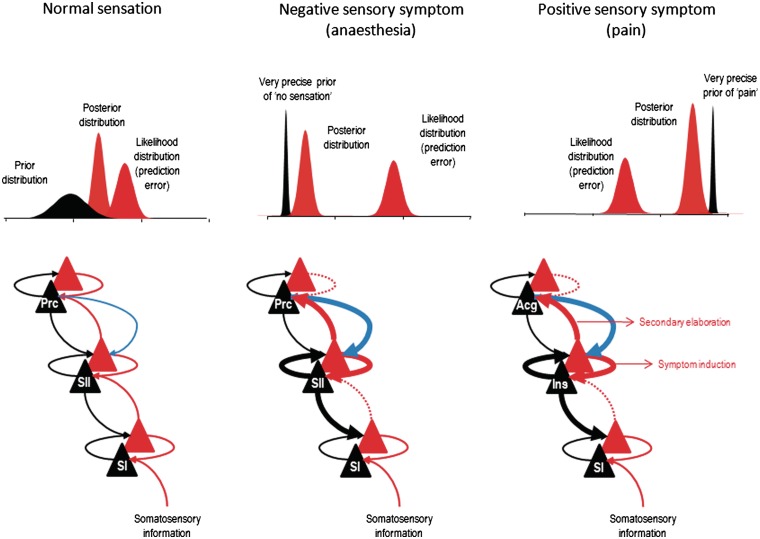Figure 3.
Here we illustrate schematically our proposal with regard to generation of functional sensory symptoms. In healthy subjects, we suggest that an intermediate hierarchical level involved in sensation (e.g. secondary sensory cortex) integrates bottom-up prediction error related to incoming sensory data (red arrows) and top-down priors about the causes of sensory data (black arrows) in an optimal way. Top: The interaction between the likelihood of sensory data and the prior beliefs over those data at this intermediate hierarchical level, which results in a posterior distribution corresponding to the percept or posterior belief. By this simplification, we do not mean that the percept occurs only at the intermediate level; in reality, its physical representations are likely to be distributed across several levels. The x-axes of the graphs in the top panels denote ‘the amount of sensation’; from none to a maximum. In FMSS, we propose that an abnormal prior belief related to sensation in the relevant domain (here illustrated as the insular cortex for pain and the secondary sensory cortex for non-painful sensation) is afforded too much precision via misdirected attentional gain from higher hierarchical levels (thick blue arrow). This increase in precision (synaptic gain) causes a shift in the posterior distribution towards the prior expectation, overwhelming the influence of bottom-up prediction errors (dotted red arrow). This results in a percept that matches the prior beliefs encoded by the intermediate level, which is impervious to bottom-up prediction errors. At the same time, a precise prediction error is returned to higher levels to excite higher-level representations or explanations for the abnormal percept—again these pathologically boosted prediction errors dominate over prediction errors at the higher level when competing to influence high-level beliefs. These beliefs may include perceptual attributes—like agency. Note that we are not proposing that increased attention to secondary sensory cortex (SII; for example) per se causes anaesthesia; the crucial factor is the pre-existence of an abnormal prior belief predicting anaesthesia, whose precision is then increased by attention to that area. The existence of a different prior belief in secondary sensory cortex would lead to a different percept. Forward connections conveying prediction error are in red, backward connections conveying predictions are in black and the descending attentional modulatory connections are in blue. Superficial pyramidal cell populations encoding prediction error are shown as red triangles while deep pyramidal cells encoding posterior expectations are depicted as black triangles. Acg = anterior cingulate; Ins = insula; Prc = precuneus; SI = primary sensory cortex; SII = secondary sensory cortex.

